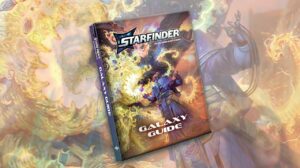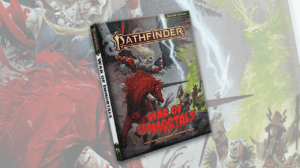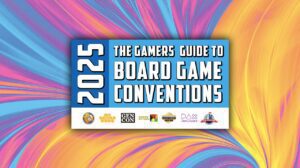Disclosure: Meeple Mountain received a free copy of this product in exchange for an honest, unbiased review. This review is not intended to be an endorsement.
Pathfinder Second Edition is generally focused on small-scale combats—your party against a small group of enemies or maybe even a single boss. But sometimes you want to tell a story on a grander stage. Maybe the party has been coordinating a huge defensive effort in an upcoming siege, or maybe they’re launching an offensive against a demonic threat resulting from an emerging Worldwound. In those cases, Paizo’s Battlecry! book has you covered.
Battlecry! Overview
Battlecry! packs a megaton of punch into a condensed package, and might be one of the more unique Pathfinder Second Edition supplements to date. It’s all about the idea of war—presented through a heroic lens—but with the acknowledgement about the horrors and tragedy that surrounds actual war. It’s not meant to glorify the history of conflict, but rather the book emphasizes the superhuman actions of the party that can supplement the fun of a fantasy roleplaying game.
The book contains two new classes: the Commander and the Guardian. Commanders revel in their mastery of the battlefield, leveraging tactics to inspire and direct their allies as they guide them to victory. Guardians thrive on their ability to soak up damage and taunt opponents into seeing them as the largest threat, and they’re often the hardest ones to bring down.
There’s also one new Ancestry in Battlecry!: Jotunborn. These beings were crafted from the remains of the rebellious titans in the early days of Golarion. They are often mistaken as descendants of giants because of their size, although the sprinkle of divinity within them makes them a far cry from giantfolk. Many also exhibit threads woven into their skin which grant magical properties, courtesy of the silk from the planar, insectile iivlar creatures that they often raise.

Battlecry! offers plenty of focus on this shiny, additional player content, dedicating two-thirds of the book to the classes, ancestry, archetypes, and an armory of weapons and magical tools geared for warfare. If you ever wanted to go into battle blasting a set of warpipes, this is finally your time to shine. Banners particularly drew my eye as they are a key mechanic for the Commander class, but they’re available to anybody to use. Attaching a banner to a weapon or shield grants effects to your allies within 30 feet, effectively allowing players of other classes to get some of the Commander flavor without fully committing to the class.
The final section of the book offers rules for skirmish combat where player characters can take command of units and influence battles where individual Troops don’t matter as much. By commanding battalions of Troops, there are rules for distributing actions between the leader and their subordinates as well as mechanics for routing enemies or establishing new command after a leader falls. These rules are not intended to beef up the Pathfinder Second Edition experience to match the complexities of something like Warhammer 40K, but they pan the lens to tell the story of combat encounters with a broader scope.
Battlecry!: A Commanding Presence
In our current playthrough of Paizo’s Sky King’s Tomb adventure path, there is an upcoming section where the skirmish rules of Battlecry! will come into effect in a big way. Without getting into too much granular detail—in case my players are reading—the adventure has had an ongoing theme of winning over the support from superiors. Evil winds of change are brewing and I am already planning on making some adjustments to the upcoming encounters to amp up the hero factor.
Troops have been around in Pathfinder Second Edition since Bestiary 3, before the remaster. They’re constantly sprinkled into Paizo’s products to break up the monotony of tokens representing single enemies. I’ve never found Troops to be overly exciting; to me they are very similar to swarms except the collective creatures that make up Troops are generally not small and diminutive vermin. I see them as variants of a theme.

However, with Battlecry!‘s introduction to skirmish rules where players can take control of Troops and be among them, suddenly I’m imagining those awesome battle scenes from movies like Aragorn in Lord of the Rings or Jon Snow in Game of Thrones. Throwing the player characters into the fray, sharing a space with the troop token, somehow grants that extra layer of cinematic oomph that provides additional stakes. When Troops lose HP and consolidate their token size, that’s on the player. I love that narrative weight.
Commander is very reminiscent of the Cavalier class from Pathfinder First Edition. Instantly at level 1, Commanders get access to five (!) Tactics, which are these powerful, battlefield shaping actions. Give your party extra reactions. Move them around. Force opponents to be Off-Guard. Whenever I whip up a new character, I want them to feel impactful from the jump instead of waiting several levels for their class to come “online”. Commander fills that void.
Guardians don’t do as much for me, but I can see their appeal. Being able to Taunt an opponent reminds me—again— of the PF1 Cavalier challenge, except that it grants a malus to the enemies if they don’t attack the Guardian doing the taunting. Having a tank character in tabletop roleplaying games is tough because unless there are some mechanics behind a character’s threats, the Gamemaster doesn’t have much holding them back from ignoring the heavily armored character standing right in front of their enemies. The Guardian, however, gives the initial impression of at least making the GM stop to think about their decision of who to attack, especially in a game where every +1 bonus/malus matters.
Battlecry! excels because of its scope. If you’re looking for support in shifting the focus from the character level to the battlefield level, then it is a fantastic resource. I would offer words of caution in doing so, however, because ultimately Pathfinder Second Edition is a game of heroes. Zooming out that lens can detract away from these individual stories.
For this reason, I plan on weaving skirmish rules into the narrative as necessary, dropping in and out of the focus on the battlefield as a tool to control the mood. Few things break tension more than stopping to reference a rule or making an agonizing decision of how to disperse actions to Troops. Instead, I see the skirmish rules as a way to bring gravity to situations, emphasize the scale of combat, but never to replace the heroics that my players love to feel.
Battlecry! has shifted my opinion on Troops, fleshing them out into vessels for exciting storytelling. It’s given me some extra homework, but—like any Commander worth their salt—I will happily Gather it To Me!












